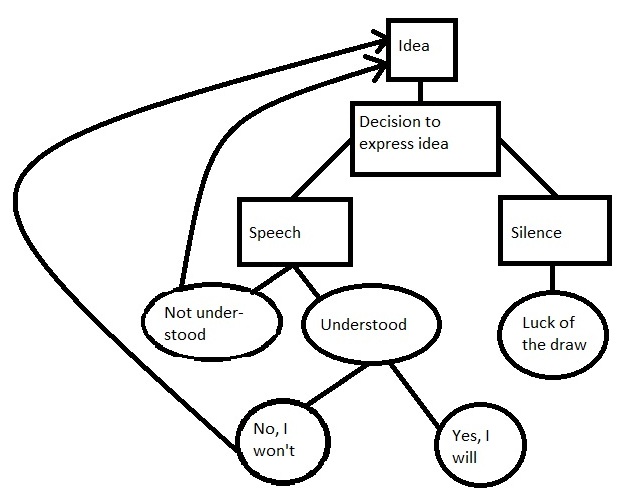 You want him to propose. You want her to have sex with you. You want your kid to do as you say. How do you make this happen?
You want him to propose. You want her to have sex with you. You want your kid to do as you say. How do you make this happen?
You probably hint at what you want. If you are brave you ask. Then you ask again.
Maybe you try justifying your request. You might even argue some about it.
Or you could act as if your right to be gratified was so obvious that the other person is remiss for not having taken action right away. Maybe you nag!
You think, how could something so simple not have been delivered? You feel injured, hurt. Perhaps you get angry and feel disrespected.
Having sent the other person various signals, do you now get what you want?
Quite possibly not. How come?
Before I tell you what I think you need to do for better results with respect to this request and others, let’s look at what actually happened.
Mulling the matter over, you went through several stages. 
You figured out what you wanted.
You attempted communication.
Communication succeeded or failed.
If communication succeeded, you got what you asked for or did not get it.
If you did not get what you asked for, you attempted communication once more.
If communication failed, you did not get what you asked for.
You either attempted communication once again, or you fell silent. If you fell silent, you began to fret, to ruminate, perhaps even to feel resentful.
In this scenario, communication is rather like a game of catch. I throw, you catch or miss. Or vice versa.
But suppose we take a different view of the situation. Not all communications you issue will succeed in any case.
Sometimes what is heard isn’t what is said. Maybe your words had a different meaning to the other person.
Or maybe you just hinted at what you wanted, and the other person didn’t get the message. Anything you say has two aspects: the content (what you expressed) and the process (how you expressed it). Either of these is open to misinterpretation.
So how do you ensure that you say what you mean and you get what you ask for? The key, as you might imagine, lies in the other person’s response.
Simply put, you want to show the other person that you are pleased with what they said or did. Then you want to offer them the opportunity to please you some more.
To make this technique effective, you need to do some leg work. You need to be encouraging, appreciative, and grateful. You could start with the assumption that the other person, whoever he or she may be, wants to have a positive experience interacting with you.
I am not saying that you want to hound the other person and suck up to him or her at every opportunity, just that when the two of you interact, you want the encounter to leave the other person feeling good.
Now, obviously this method needs tweaking if the other person has done something to offend or anger you. Your dearly beloved lied or told you a half truth. Your child disobeyed you or ignored your directive.
When these things happen, you cannot be joyful or encouraging. You can downplay the incident, however. I don’t mean ignore it. I mean refrain from reinforcing it by giving the offender lots of attention in connection with the problem.
Huh?
The key is this simple truth. We all want the approval of the important people in our lives. We are constantly seeking proof that we have it.
Consequently, if you want us to do something, you will show us that we have pleased you—and you will hint that we can please you some more by doing this new thing that you have just specified.
When we screw up and do something that displeases you, you can make your sentiments known, but you want to withhold the goodies. You want to avoid giving us the pats and attention we crave until we do what you like.
Psychologists call this approach to human behavior “shaping.” It is far more effective than arguing or browbeating. It depends for its success on psychic rewards, which influence behavior far better than punishment.
Anger, threats, and penalties are fairly primitive responses to other people’s actions. Think: an eye for an eye and a tooth for a tooth. Sounds painful, right? Payback builds anger, resentment, and hostility in the other person.
Rewards, on the other hand, are as sweet as honey. Remember the old saying, “You catch more flies with honey than with vinegar”? Nowhere is this truer than in the realm of human behavior.
You can even use this approach when you are enforcing household rules with your defiant five-year-old. The kid deliberately disobeyed you. You want him to take a time out to think the matter over.
How does a time out encourage good behavior? You’re right: all by itself it doesn’t, because it feels like punishment. But if your child bends to your will and actually goes to his room to do the time out, you can seize this opportunity to praise him.
In this way you reduce the likelihood of another time out, and you remind him, subtly, that doing what you ask brings the affection and approval he wants.
You can even try this with your boss. You may not like her management style, but if you can catch her doing something you appreciate, and you thank her, you plant a seed. The more appreciative you can be, the more responsive your boss is likely to become.
The takeaway? All of us want more than anything else to please the important people in our lives. If you show us how to please you, we will notice and remember. Then we will use this knowledge to elicit from you the respect and caring we crave.
